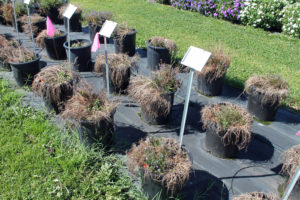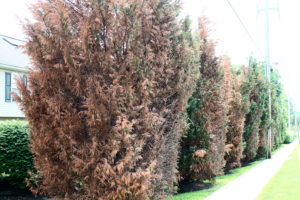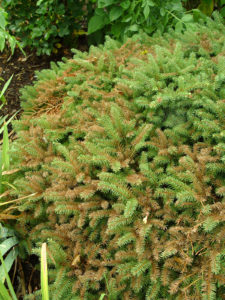Temperature Guessing
April 25th, 2017
Some plants like it hot. Some like it cold. But no plant is happy in heat or cold that goes beyond what its genetics will tolerate.
It’s why Pennsylvania gardeners can’t grow crotons or orange trees outside – and why Floridians can’t do lady’s mantle or Norway spruce.
Knowing a plant’s temperature tolerance is one of the most important parts of deciding what to plant where.
Guess wrong on the cold end, and the results are obvious. You end up with dead or badly damaged plants at the end of winter or on the morning after that surprise frost.
Misfiring on the hot end is more subtle. Plants may not react as suddenly and harshly, but they’ll suffer from setbacks such as stunted growth, poor leaf color, flower shutdowns, and in the case of some vegetables, bitter flavor.
So how do you know if a plant is suited temperature-wise to our yards?
One guide is what’s being offered at local garden centers and nurseries. Local garden-center buyers generally do the homework for you and, from experience, filter out plants our weather is likely to kill.
Dead plants create unhappy customers, so if you’re a garden center, it makes sense to carry likely winners and sort them into sections such as “Nursery” and “Perennials” (hardy) vs. “Annuals” and “Houseplants” (will croak outside in winter).
But what if you’re not convinced? What if you buy out-of-town? Or what about that alluring shrub that caught your eye online?
Two other guides can help.
One is the U.S. Department of Agriculture’s Plant Hardiness Zone Map, which breaks the country down into 13 zones by their average lowest temperatures in winter.
The other is a less known rating system from the American Horticultural Society that does the same thing by heat – dividing the country into 12 zones by the number of days above 86 degrees it averages each year.
The USDA’s “cold-zone” map has been around since 1960 and was updated in 2012, using weather data from between 1976 and 2005.
The map’s 13 zones comprise 10-degree segments according to the average winter lows recorded during those 30 years. For example, most of central Pennsylvania falls into Zone 6, which means winter lows usually bottom out between 0 and minus-10 degrees.
However, in and around Harrisburg and heading into the southern fringe of central Pennsylvania, that’s Zone 7a territory, meaning average lows of 0 to 5 above. Heading north, we get into Zone 5b, meaning winter lows that can dip into minus-10 to minus-15.
Agree with its nuances or not, USDA’s rating system has been widely accepted in the plant industry. Almost all plants are rated by numbers that correspond to USDA’s 13 hardiness zones.
Those are the numbers you’ll see listed on plant tags and in plant references.
Example: A listing of USDA Hardiness Zones 4-8 means the plant can be expected to tolerate the winter colds in Zones 4 through 8 – or in other words, lows anywhere between minus-30 and 20 degrees above.
USDA’s updated map is posted online and has a new interactive feature that lets you type in your Zip code to find your area’s exact zone rating.
One other upgrade… the new map factored in more temperature-affecting specifics, such as nearness to water (which can keep things a little warmer in winter) and topography (higher elevations usually mean colder temperatures in winter).
The AHS Plant Heat Zone Map looks at how plants perform in heat, measuring that by the number of days an area experiences daytime highs of at least 86 degrees. That’s the point where AHS deemed that plants generally begin to experience heat stress.
Developed in the 1990s, this map offers zones ranging from 1 (less than one “heat day” per year) to 12 (more than 210 heat days per year).
The late president of AHS, Dr. H. Marc Cathey, offered heat ratings for a few hundred plants in his 1998 Time-Life book, “Heat-Zone Gardening,” but the system hasn’t caught on to the degree of the USDA cold ratings.
Most plant tags and references list just the USDA numbers, but some list both those and AHS heat ratings.
If you see two sets of numbers on a plant tag, the first is its cold rating and the second is it heat rating. Example: a tulip lists ratings of “3-8, 8-1.” That means it can take cold down to USDA Zone 3, but it doesn’t do well in the heat of AHS zones above 8.
AHS says that thousands of plants have been heat-rated, and more are in the pipeline as it attempts to popularize the idea.
Keep in mind that both of these are guides.
The ratings don’t take into account all-time or possible future excesses, and as any gardener will tell you, weather is often more erratic than average.
The winter of 2013-14 proved that point by vortexing itself below the average minimums after a string of above-average winters – killing a lot of camellias, osmanthus, laurels and other landscape plants that many gardeners had come to consider “safe” bets.
The lesson: Just because a shrub is rated for Zone 6 doesn’t mean it’s a lock to never die in Zone 6.
The opposite also is true. Gardeners who like to push the envelope with plants rated a zone out of their reach might well be successful – especially if they’re taking advantage of warmer microclimates in the yard, such as planting along a south-facing stone wall or planting in a fence-enclosed courtyard.
The lesson there: Enjoy the plant while you can, but don’t be surprised if your string of Zone 7-like winters in Zone 6 suddenly becomes Zone 5-like for a few weeks one January.
As USDA points out in its map-using tips, “No hardiness zone map can take the place of the detailed knowledge that gardeners pick up about their own gardens through hands-on experience.”
To help with your plant-picking temperature-wise, here are some specifics on what I’ve found over the years:

These pots of annual lobelia at Penn State’s Trial Gardens show what this species thinks of 90-degree heat.
Plants that don’t like it hot: cedar, delphinium, enkianthus, fir, forget-me-not, heather, hemlock, lady’s mantle, lychnis, marsh marigold, primrose, pussy toes, spruce, verbascum, Virginia bluebell, yew, pansies, violas, annual lobelia, nemesia, cape daisies (Osteospermum), marguerite daisies.
Plants at risk in an unusually cold Pa. winter: Arizona cypress, camellia, cedar, crape myrtle, crocosmia, English holly, Japanese plum yew, Japanese snowbell, laurels (cherry, Portugal and “schip”), Leyland cypress, nandina, rose (some), skimmia, osmanthus, vitex.
Some of the most heat-tolerant annuals: ageratum, begonia, canna, cleome, cosmos, geranium, heliotrope, marigold, melampodium, nasturtium, nicotiana, portulaca, salvia, sunflower, verbena, vinca, zinnia.
Some of the most heat-tolerant perennials: agastache, artemisia, black-eyed susan, blanket flower, boltonia, catmint, cimicifuga, coralbells, coreopsis, daylily, garden phlox, gaura, goldenrod, hardy geranium, hollyhock, lavender, liatris, mum, penstemon, purple coneflower, salvia, spiderwort.
Some of the most heat-tolerant trees and shrubs: abelia, aralia, arborvitae, bald cypress, beautyberry, beech, birch, boxwood, butterfly bush, caryopteris, chokeberry, clematis, crape myrtle, dogwood, flowering pear, fothergilla, hawthorn, holly, honeylocust, juniper, oak, magnolia, maple, pieris, pine, redbud, rhododendron, shrub rose, smoketree, spirea, summersweet, St. Johnswort, sweetbox, quince, Virginia sweetspire.









